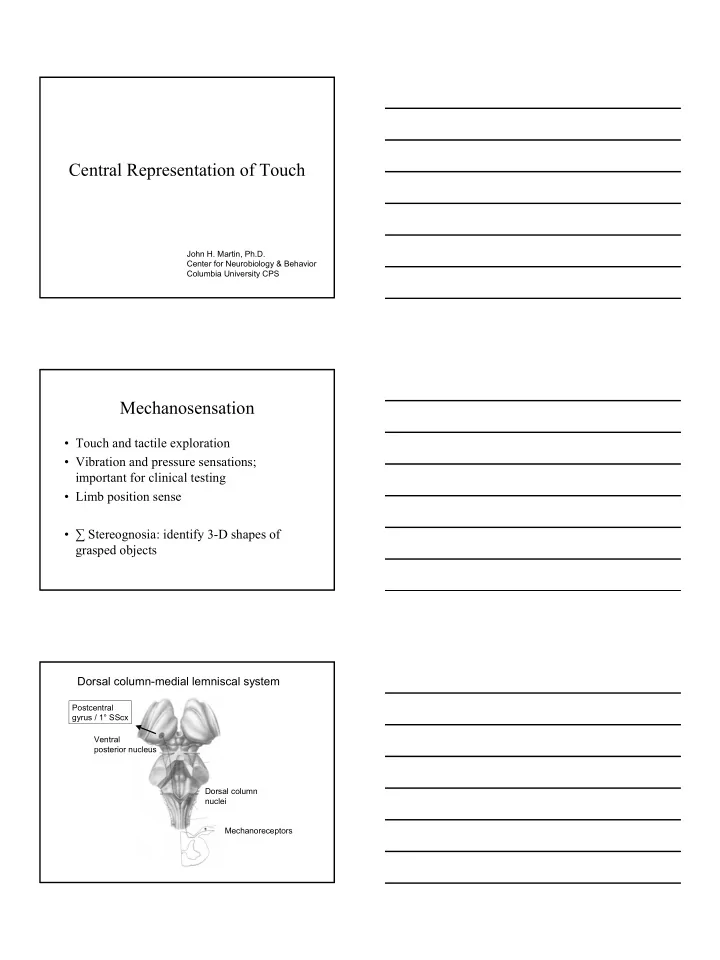

Central Representation of Touch John H. Martin, Ph.D. Center for Neurobiology & Behavior Columbia University CPS Mechanosensation • Touch and tactile exploration • Vibration and pressure sensations; important for clinical testing • Limb position sense • ∑ Stereognosia: identify 3-D shapes of grasped objects Dorsal column-medial lemniscal system Postcentral gyrus / 1° SScx Ventral posterior nucleus Dorsal column nuclei Mechanoreceptors 1
•Somatotopic organization •Receptive field structure: key properties for tactile acuity •Other functions of inhibition •Cortical columns, submodality representation, and cortical mechanisms for higher somatic sensory functions •Elaboration of somatic sensory processing in higher-order sensory and association areas Somatotopic Organization • Preserves neighborhood relations • Like a slide projector – Slide=peripheral receptive sheet – Light=peripheral and central pathways – Screen=central nervous system representation • All processing stages and tracts in touch pathway are somatotopically organized • Similar organization for vision (retinotopic) and auditory system (tonotopic) Wilder Penfield What does the homunculus in the postcentral gyrus tell us …stimulus localization & about somatic sensory processing? discrimination 2
2 Point Discrimination Good Poor What is the basis of distortions in the cortical homunculus? …receptive field structure CNS neurons have receptive fields Convergence: CNS receptive fields >> PNS receptive fields Receptor innervation density increases from proximal to distal CNSreceptive field size decreases from proximal � distal and overlap increases 3
Receptor innervation density increases from proximal to distal CNSreceptive field size decreases from proximal � distal and overlap Representational area increases inversely proportional to RF area Map distortions reflect genetics and experience 4
•Somatotopic organization •Receptive field structure: key properties for tactile acuity •Other functions of inhibition •Cortical columns, submodality representation, and cortical mechanisms for higher somatic sensory functions •Elaboration of somatic sensory processing in higher-order sensory and association areas Receptive field Primary sensory neuron RF CNS neuron RF Structural basis of RF: distribution of sensory fiber innervation Receptive field structure Primary sensory neuron RF CNS neuron RF 5
Gradient of excitation within excitatory RF in CNS neurons Gradient of excitation effectively reduces RF size to center …RF area increases with stronger stimuli; not veridical Receptive field structure Primary sensory neuron RF CNS neuron RF Inhibitory RF Inhibitory interneuron Excitatory RF 6
Background neural activity drops Increase signal-to-noise ratio Mechanoreceptor response CNS neuron response to stimulus 7
Receptive Field Structure • Gradient of + sharpens neural response to center of RF, which is most sensitive • Inhibitory RF turns neuron off before it is activated by stimulus, thereby increasing S/N Other uses for inhibition in sensory systems: Stimulus feature extraction Other uses for inhibition in sensory systems: Distal inhibition--usually top down Cortical neuron excites inhibitory interneuron Inhibitory interneuron + inhibits projection neuron - in nucleus Effect: blocks or fine-tunes transmission through nucleus 8
How is information from different mechanoreceptors represented in primary somatic sensory cortex? Rapid adaptation Slow adaptation Mechanoreceptors Meissner Merkel Pacinian Ruffini Slowly adapting Meissner Pacinian Time 9
Texture code: • Different receptors respond to different components of complex stimulus • Internal representation of a texture determined by activity in population of diverse mechanoreceptors How is receptor information represented in the primary somatic sensory cortex? • Cell-stained section (Nissl) • most 6 cell layers Pyramidal neuron: projection neuron Layer 1 Layers 2 & 3 Layer 4 Stellate Neuron: interneuron Layer 5 Layer 6 •neuron density varies 10
Layer 1 Layers 2 & 3 Layer 4 Layer 5 Layer 6 RA-Meissner SA-Ruffini RA-Meissner SA-Merkel RA-Pacinian Columnar organization Different textures produce different •same receptor column activation patterns •same location Pyramidal neuron: projection neuron Layer 1 Layers 2 & 3 Layer 4 Stellate Neuron: interneuron Layer 5 Layer 6 from to other cortical back to Thalamus areas Thalamus to Subcortical areas Columnar organization of 1° SScx Input from: 1 2 3 Thalamus 4 5 6 1 2, 3 4 5 6 11
Columnar organization of 1° SScx Projects to: 1 Other cortical areas 2 3 Brain stem, spinal cord, basal ganglia 4 Thalamus 5 6 1 2, 3 4 5 6 Body representation w/in each cytoarchitectonic area Processing mechanoreceptive information within the Primary Somatic Sensory Cortex Deep Area 3a Ventral posterior nucleus Area 3b Area 1 Area 2 Cutaneous Integrated representation: ?stereognosia 12
Processing mechanoreceptive information within the Primary Somatic Sensory Cortex Posterior parietal cortex, Deep insular cortex, motor cortex Area 3a --- “top down control” Area 3b Area 1 Area 2 Cutaneous Summary • Touch path has hierarchical organization – Not bucket brigade – Message transformed • Several mechanisms for enhancing spatial acuity – Gradient of excitation – Surround inhibition • Columnar organization of cortex – Same input (receptor and location) • Intracortical processing leads to integrated representation Conclusions • Bottom up – Receptors to spinal cord to cortex • Top down – Cortex to subcortical centers - Layers 5, 6 – Other cortical areas project into somatic sensory cortex • Result – Experience and expectation modulates stimulus processing, both subcortically in relay nuclei and in cortex • illusions – Pathological states can generate sensation de novo • halucinations 13
Recommend
More recommend